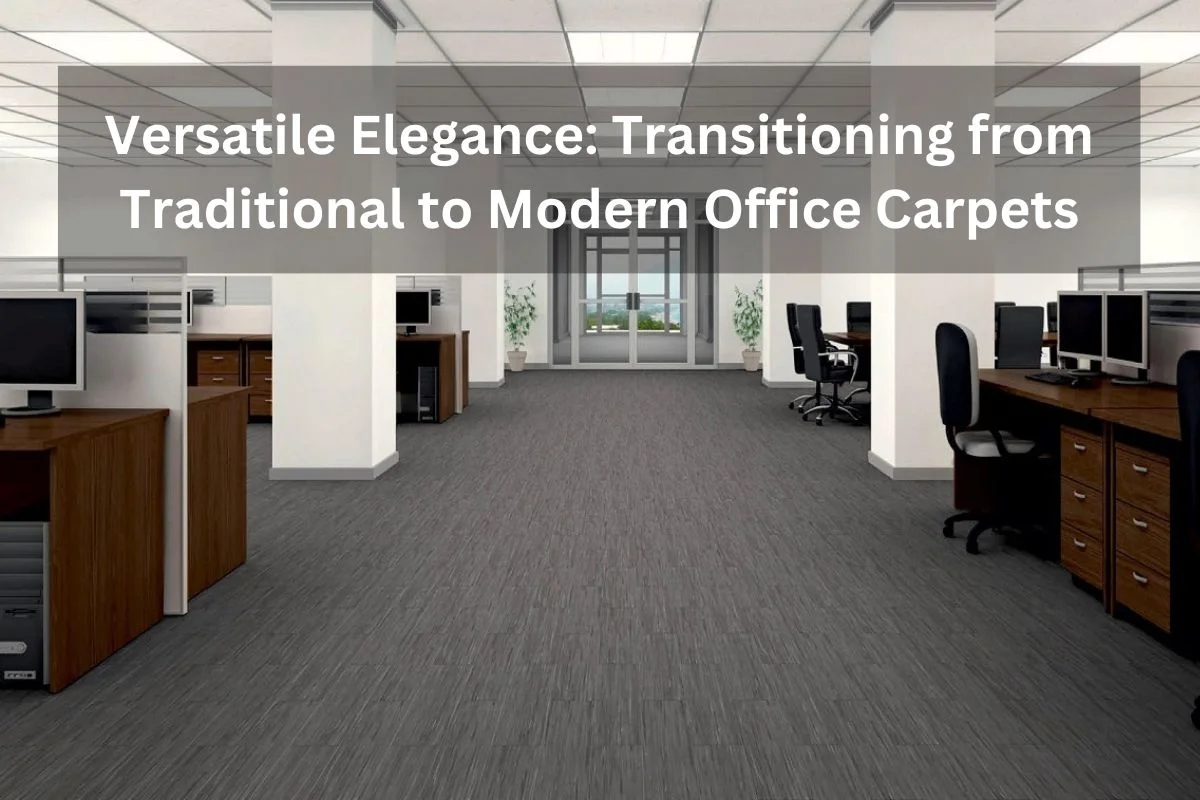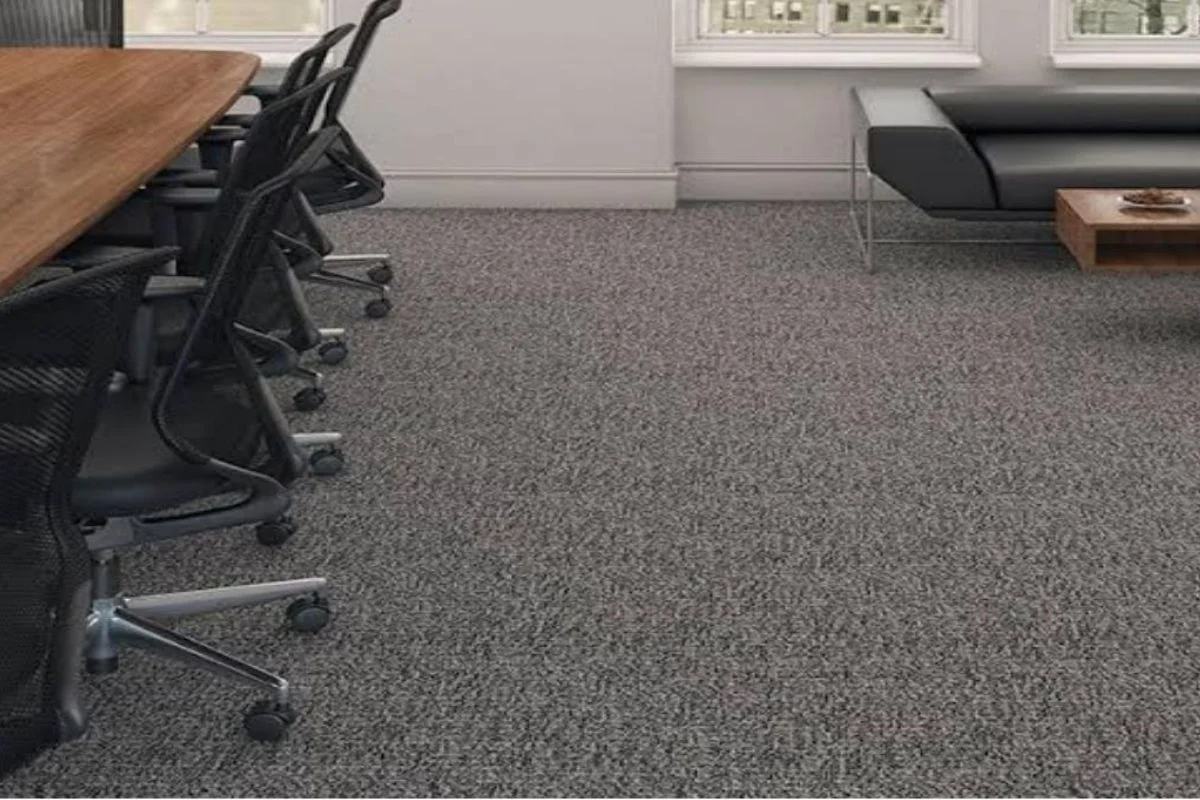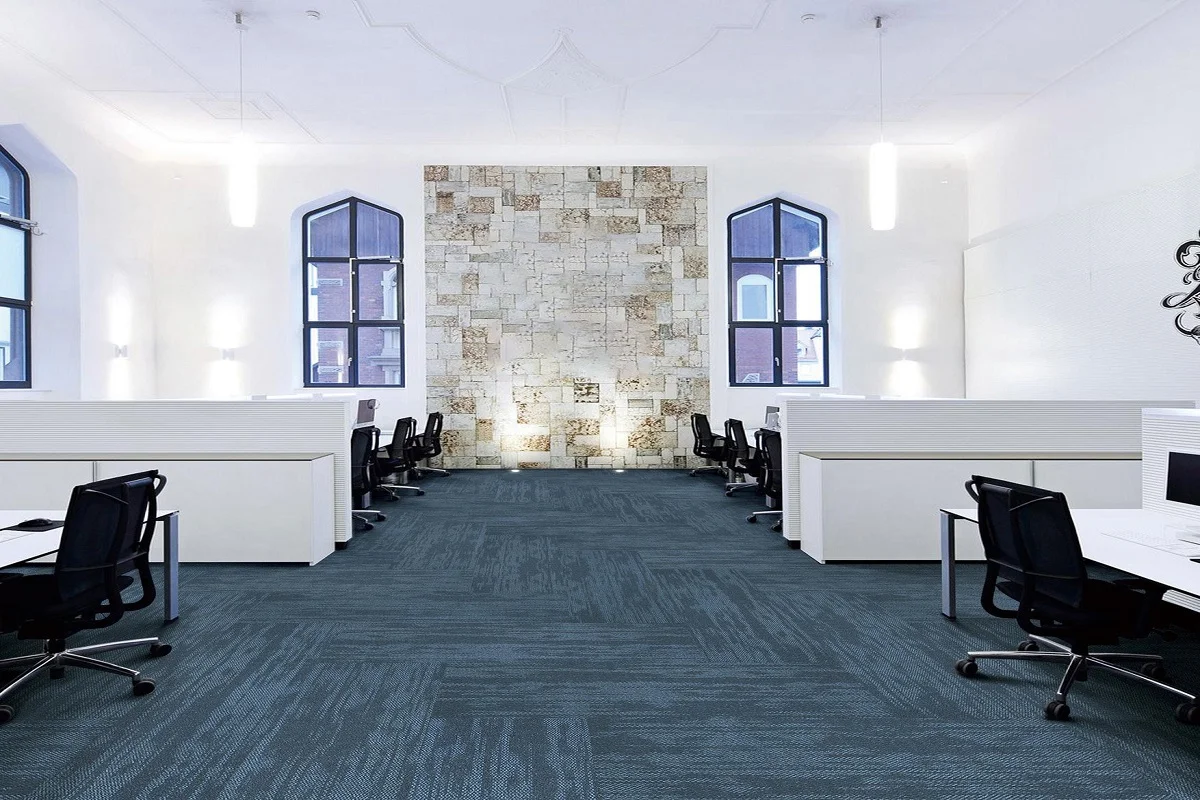In the ever-evolving landscape of office design, the flooring beneath our feet plays a pivotal role in setting the tone for the entire workspace. As we navigate the transition from traditional to modern office aesthetics, one element stands out for its ability to seamlessly bridge the gap between timeless sophistication and contemporary flair – office carpets. Versatile in their design and functionality, modern office carpets have become a defining feature in creating work environments that reflect both style and practicality.
Gone are the days when office carpets were solely associated with conservative patterns and muted colours. Today, they serve as dynamic design elements that can transform the atmosphere of a workspace. This transition from the traditional to the modern is not merely a shift in appearance; it represents a broader movement toward creating offices that are not only visually appealing but also adaptive to the diverse needs of a modern workforce.
Join us on a journey through the world of office carpets as we explore the nuances of their design, the benefits they bring to contemporary workplaces, and how they contribute to the overall elegance and functionality of a modern office space. Whether you’re an architect, a facilities manager, or simply someone with a keen interest in the intersection of design and functionality, this exploration will guide you through the process of embracing versatile elegance in the realm of office carpets.
Brief overview of the significance of office carpets in modern workspace design
In the realm of modern workspace design, office carpets stand as integral components that transcend mere floor coverings. Beyond their utilitarian function, these carpets play a pivotal role in shaping the aesthetic and functional aspects of contemporary offices. The significance of office carpets lies in their ability to seamlessly blend style and practicality, creating environments that not only please the eye but also enhance the overall workplace experience.
Aesthetic Appeal:
Office carpets contribute significantly to the visual appeal of a workspace. They serve as canvases where designers can play with colours, patterns, and textures, transforming an ordinary office floor into a vibrant and inviting space. The aesthetic choices made in carpet selection contribute to the overall ambiance, reflecting the company’s brand, culture, and the desired atmosphere of the workspace.
Brand Identity and Customization:
Beyond their decorative role, office carpets offer a unique opportunity for companies to express their brand identity. Customization options allow businesses to incorporate logos, brand colours, and specific design elements directly into the carpet, creating a branded environment that fosters a sense of identity and belonging among employees and visitors.
Comfort and Productivity:
Modern office carpets are designed not only for visual appeal but also for functionality. They contribute significantly to the comfort of the workspace by providing a soft and supportive surface underfoot. This comfort, in turn, positively impacts employee well-being and productivity, creating a conducive environment for focused work and collaboration.
Acoustic Comfort:
With the rise of open-office layouts, managing noise has become crucial. Office carpets act as effective sound absorbers, reducing echoes and minimising noise levels. This acoustic comfort enhances the overall working conditions, fostering a more peaceful and productive atmosphere.
Versatility in Design:
Unlike traditional carpets that may have been limited in design choices, modern office carpets offer a wide range of styles and materials. This versatility allows designers and businesses to experiment with different looks, adapting to evolving trends and the specific needs of diverse office spaces.
Benefits of choosing sustainable office carpets
choosing sustainable office carpets offers a range of benefits that extend beyond mere environmental considerations. Here are several advantages associated with opting for eco-friendly carpeting in the workplace:
Environmental Impact:
Sustainable office carpets are crafted from recycled or renewable materials, reducing the demand for new resources and minimising the environmental footprint. This choice contributes to the conservation of natural resources and promotes responsible manufacturing practices.
Indoor Air Quality:
Many sustainable carpets use low-VOC (Volatile Organic Compound) adhesives and backing materials, enhancing indoor air quality. This promotes a healthier workspace by reducing the emission of harmful chemicals, creating a more comfortable and safe environment for employees.
Energy Efficiency:
The production of sustainable carpets often involves less energy consumption compared to traditional manufacturing processes. Choosing these carpets supports energy-efficient practices and aligns with a commitment to reducing overall energy consumption in the office.
Long-Term Durability:
Sustainable carpets are designed with durability in mind. Their longevity reduces the need for frequent replacements, saving resources and reducing waste. This not only benefits the environment but also proves cost-effective over the long term.
Waste Reduction:
Sustainable carpet manufacturers prioritise recycling and waste reduction. Materials used in the production process are often recyclable, and some companies offer take-back programs, ensuring that old carpets are recycled rather than ending up in landfills.
Corporate Social Responsibility (CSR):
Choosing sustainable office carpets aligns with a company’s commitment to corporate social responsibility. It demonstrates a dedication to environmentally friendly practices, positively impacting a company’s image and contributing to a more sustainable business model.
Employee Well-being:
Sustainable carpets contribute to a healthier and more comfortable workspace. With reduced exposure to harmful chemicals and improved indoor air quality, employees can enjoy a workspace that supports their well-being, leading to increased satisfaction and productivity.
Regulatory Compliance:
As environmental regulations become more stringent, opting for sustainable office carpets ensures compliance with evolving standards. This proactive approach helps companies avoid potential legal issues and aligns with the growing global focus on sustainable business practices.
Functionality and Practicality of Office Carpet
The functionality and practicality of office carpets extend beyond their aesthetic appeal, playing a crucial role in creating a comfortable and efficient workspace. Here are key aspects highlighting their functional significance:
Acoustic Comfort:
Office carpets contribute significantly to managing sound within a workspace. They act as effective sound absorbers, reducing echoes and minimising noise levels. This is particularly valuable in open office layouts, promoting a quieter and more focused work environment.
Comfort Underfoot:
Providing a soft and comfortable surface underfoot, office carpets enhance overall comfort in the workplace. This feature is essential for employees who spend extended hours at their desks, contributing to a more ergonomic and employee-friendly atmosphere.
Thermal Insulation:
Carpets act as thermal insulators, helping to maintain a comfortable temperature in the office. They provide an additional layer of insulation, reducing energy costs by retaining warmth in colder months and keeping the space cooler during warmer seasons.
Safety and Slip Resistance:
Carpets offer a non-slip surface, enhancing safety in the workplace. This is especially important in areas with high foot traffic or where spills are likely to occur. The slip-resistant nature of carpets contributes to a safer working environment.
Durability and Longevity:
Well-maintained office carpets are durable and can withstand heavy foot traffic. Their longevity reduces the need for frequent replacements, resulting in cost savings and minimising the environmental impact associated with the production and disposal of carpeting materials.
Customization for Different Spaces:
Office carpets can be tailored to suit the specific needs of different areas within the workplace. Whether in meeting rooms, collaborative spaces, or individual workstations, the ability to customise carpet designs allows for a cohesive yet adaptable interior design.
Health and Hygiene:
Carpets contribute to a healthier indoor environment by trapping dust and allergens, preventing them from becoming airborne. Regular maintenance, including vacuuming and professional cleaning, helps maintain a hygienic workspace and minimises the risk of respiratory issues.
Branding and Corporate Identity:
Beyond functionality, office carpets offer an opportunity for branding and expressing corporate identity. Customization options allow businesses to incorporate logos, colours, and design elements into the carpet, reinforcing brand presence throughout the workspace.
Ease of Maintenance:
Many modern office carpets are designed for easy maintenance. Stain-resistant materials and treatments simplify the cleaning process, making it more convenient for facilities managers to keep the workspace looking fresh and presentable.
Tips for Choosing the Right Office Carpet
Choosing the right office carpet involves considering various factors to ensure that it not only complements the aesthetic of the space but also meets functional requirements. Here are some essential tips to guide you in selecting the perfect office carpet:
Consider Traffic Levels:
Assess the foot traffic in different areas of the office. High-traffic zones, such as entrances and hallways, may require more durable and stain-resistant carpeting, while low-traffic areas may allow for more luxurious or design-centric options.
Understand Maintenance Requirements:
Be realistic about the maintenance capacity of your office. If your team can commit to regular cleaning and maintenance, you might have more flexibility in choosing a higher-maintenance carpet. Otherwise, opt for low-maintenance options that are easy to clean and maintain.
Balance Design with Functionality:
for a balance between design aesthetics and practical functionality. Consider the visual appeal of the carpet in relation to your office’s overall design while ensuring it meets the functional needs of the space, such as ease of maintenance and durability.
Customization for Branding:
If branding is important, explore customization options. Many carpet manufacturers offer the ability to incorporate logos, brand colours, and specific design elements into the carpet, allowing you to reinforce your company’s identity throughout the workspace.
Think About Acoustic Comfort:
In open-plan offices, consider the acoustic properties of the carpet. Carpets can contribute to noise reduction, creating a quieter and more focused work environment. Look for carpets with good sound-absorbing qualities for enhanced acoustic comfort.
Choose Appropriate Carpet Fibre:
Different carpet fibres have varying levels of durability and stain resistance. Nylon is known for its durability, while wool provides a luxurious feel. Assess the pros and cons of each fiber type based on your office’s specific needs.
Evaluate Color and Pattern:
The colour and pattern of the carpet can significantly impact the overall atmosphere of the office. Lighter colours may make a space feel more open, while patterns can add visual interest. Consider the existing colour scheme and design elements in your office when making choices.
Think About Allergen Considerations:
If allergies are a concern, choose carpets with hypoallergenic and anti-microbial features. These carpets can help improve indoor air quality by minimising the presence of allergens and promoting a healthier workspace.
Test Samples in Different Lighting:
Before making a final decision, obtain samples of potential carpets and test them in various lighting conditions within your office. This helps ensure that the colour and texture align with your vision for the space.
Consult with Professionals:
Seek advice from flooring professionals or interior designers. Their expertise can guide you through the selection process, considering not only aesthetics but also the technical aspects of installation and long-term performance.
Maintenance and cleaning tips for Office Carpets
Maintaining and cleaning office carpets is essential for preserving their appearance, longevity, and the overall hygiene of the workspace. Here are practical tips to keep your office carpets in optimal condition:
Regular Vacuuming:
Implement a routine vacuuming schedule to remove surface dirt, dust, and debris. High-traffic areas may require more frequent vacuuming to prevent the accumulation of dirt that can damage carpet fibres.
Address Spills Immediately:
Attend spills promptly to prevent stains. Blot the spill with a clean, dry cloth or paper towel to absorb as much liquid as possible. Avoid rubbing, as it can spread the stain and damage the carpet fibres.
Use the Right Cleaning Products:
Choose cleaning products that are suitable for your carpet type. Test any cleaning solution in an inconspicuous area first to ensure it doesn’t cause discoloration or damage. Follow the manufacturer’s recommendations for approved cleaning agents.
Professional Cleaning Services:
Schedule regular professional carpet cleaning services to deep-clean and refresh the carpets. Professional cleaners have the expertise and equipment to remove embedded dirt and stains effectively.
Invest in Stain-Resistant Carpets:
Consider installing stain-resistant carpets, especially in high-traffic areas or places prone to spills. These carpets are treated with protective coatings that make it easier to clean and prevent stains from setting.
Entrance Mats and Runners:
Place entrance mats at the entrances of the office to trap dirt and moisture before it reaches the carpets. Runners in high-traffic corridors can also protect the carpet from wear and tear.
Rotate Furniture:
Periodically rearrange furniture to distribute the weight and foot traffic evenly across the carpet. This helps prevent uneven wear and extends the life of the carpet.
Use Furniture Pads:
Place furniture pads under the legs of desks, chairs, and other heavy furniture to prevent indentations and damage to the carpet fibres.
Regular Inspection:
Conduct regular inspections of the carpets to identify and address any issues promptly. Look for signs of wear, stains, or damage, and take appropriate action to prevent further deterioration.
Control Humidity Levels:
Maintain optimal indoor humidity levels to prevent mould and mildew growth in the carpet. Use dehumidifiers if necessary, especially in areas prone to high humidity.
Conclusion
In conclusion, the role of office carpets in modern workspace design extends far beyond being mere floor coverings. As we’ve explored the significance, functionality, and practicality of these essential elements, it’s evident that they contribute to the overall aesthetic appeal, brand identity, and well-being of a workplace.
The careful selection of office carpets involves a delicate balance between design preferences and functional requirements. From choosing sustainable options that align with environmental values to considering the acoustic comfort and maintenance needs, each decision plays a part in shaping a conducive and inspiring work environment.




